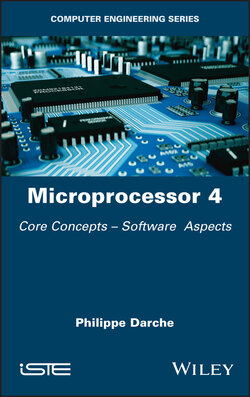Читать книгу Microprocessor 4 - Philippe Darche - Страница 29
1.2.4.2. (Implicit) stack addressing
ОглавлениеOperands are found implicitly (i.e. they are not named) on the stack which is, we recall (cf. § 4.1), access to LIFO (Last-In/First-Out, push-in/pop-out or push- down/pop-up memory) and implemented in primary memory in modern MPU. The two primitives (i.e. functions) to access it are stacking() and unstacking(), translated into instructions respectively by push() and pop(), for example, in x86 architecture. These instructions implement, internally, an indirect addressing mechanism with the Stack Pointer register (SP), which memorizes the address at the top of the stack. The stack is implemented in main memory, but it can be implemented in the processor. The stacked element is specified with the operand. There are also specific instructions to a register, such as pha/pla (push/pull accumulator onto/from stack) from MC6800, which makes it possible to stack/destack this MPU's accumulator. MCS6502 uses php/plp (push/pull processor status on/from stack) this time for the MPU's context. By extension, stack computers do not explicitly name the operands (zero-operand, one-operand or two-operand addressing). For reading on this subject, see Koopman (1989).
The NS3200 (Hunter 1987) from National Semiconductor (NS) has broadened access to the stack by offering a mode called top-of-stack, literally “stack top”, which makes it possible to access the data of the so-called summit, since modification of the pointer is not systematic (i.e. dependent on the operation). To finish with this topic, MPUs such as the families Arm®, PowerPC or MC68000 make it possible to use General-Purpose Registers (GPR) as stack pointers. The addressing mode is of indirect type with auto-increment/decrement.
